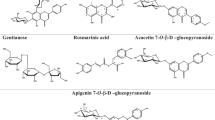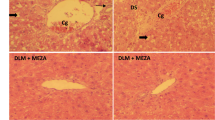Abstract
Pretreating mice with schisandrin B (Sch B), a dibenzocyclooctadiene derivative isolated from the fruit of Schisandra chinensis, at a daily dose of 1 mmol/kg for 3 days protected against menadione-induced hepatic oxidative damage in mice, as evidenced by decreases in plasma alanine aminotransferase activity (78%) and hepatic malondialdehyde level (70%), when compared with the menadione intoxicated control. In order to define the biochemical mechanism involved in the hepatoprotection afforded by Sch B pretreatment, we examined the activity of DT-diaphorase (DTD) in hepatocytes isolated from Sch B pretreated rats. Hepatocytes isolated from Sch B pretreated (a daily dose of 1 mmol/kg for 3 days) rats showed a significant increase (25%) in DTD activity. The increase in DTD activity was associated with the enhanced rate of menadione elimination in the hepatocyte culture. The ensemble of results suggests that the ability of Sch B pretreatment to enhance hepatocellular DTD activity may at least in part be attributed to the protection against menadione hepatotoxicity.
Similar content being viewed by others
Referencesai
Margolin KA, Akman SA, Leong LA, Morgan RJ, Somlo G, Raschko JW, Ahn C, Doroshow JH: Phase I study of mitomycin C and menadione in advanced solid tumors. Cancer Chemother Pharmacol 36: 293–298, 1995
Tetef M, Margolin K, Ahn C, Akman S, Chow W, Leong L, Morgan RJ, Jr, Raschko J, Somlo G, Doroshow JH: Mitomycin C and menadione for the treatment of lung cancer: A phase II trial. Invest New Drugs 13: 157–162, 1995
Morrison H, Jernstrom B, Nordenskjold M, Thor H, Orrenius S: Induction of DNA damage by menadione (2-methyl-1,4-naphthoquinone) in primary cultures of rat hepatocytes. Biochem Pharmacol 33: 1763–1769, 1984
Mirabelli F, Salis A, Perotti M, Taddei F, Bellomo G, Orrenius S: Alterations of surface morphology caused by the metabolism of menadione in mammalian cells are associated with the oxidation of critical sulfhydryl groups in cytoskeletal proteins. Biochem Pharmacol 37: 3423–3427, 1988
Nicotera P, McConkey D, Svensson SA, Bellomo G, Orrenius S: Correlation between cytosolic Ca2+ concentration and cytotoxicity in hepatocytes exposed to oxidative stress. Toxicology 52: 55–63, 1988
Nutter LM, Ngo EO, Fisher GR, Gutierrez PL: DNA strand scission and free radical production in menadione-treated cells. Correlation with cytotoxicity and role of NADPH quinone acceptor oxidoreductase. J Biol Chem 267 2474–2479 1992
Thor H, Smith MT, Hartzell P, Bellomo G, Jewell SA, Orrenius S: The metabolism of menadione (2-methyl-1,4-naphthoquinone) by isolated hepatocytes. A study of the implications of oxidative stress in intact cells. J Biol Chem 257: 12419–12425, 1982
Li XY: Bioactivity of neolignans from fructus Schizandrae. Memorias do Instituto Oswaldo Cruz 86 Suppl 2: 31–37, 1991
Ip SP, Poon MKT, Wu SS, Che CT, Ng KH, Kong YC, Ko KM: Effect of schisandrin B on hepatic glutathione antioxidant system in mice: Protection against carbon tetrachloride toxicity. Planta Med 61: 398–401, 1995
Ip SP, Ko KM: The crucial antioxidant action of schisandrin B in protecting against carbon tetrachloride hepatotoxicity in mice: A comparative study with butylated hydroxytoluene. Biochem Pharmacol 52: 1687–1693, 1996
Ip SP, Poon MKT, Che CT, Ng KH, Kong YC, Ko KM: Schisandrin B protects against carbon tetrachloride toxicity by enhancing the mitochondrial glutathione redox status in mouse liver. Free Radical Biol Med 21: 709–712,1996
Liu KT, Cresteil T, Columelli S, Lesca P: Pharmacological properties of dibenzo[a,c]cyclooctene derivatives isolated from Fructus Schizandrae chinensis. II. Induction of phenobarbital-like hepatic monooxygenases. Chemico-Biol Interact 39: 315–330, 1982
Berry MN, Edwards AM Barritt: High-yield preparation of isolated hepatocytes from rat liver. In: R.H. Burdon, P.H. van Knippenberg (eds). Isolation Hepatocytes Preparation, Properties and Applications. Elsevier, New York, 1991, pp 15–58
Chung JH, Seo DC, Chung SH, Lee JY, Seung SA: Metabolism and cytotoxicity of menadione and its metabolite in rat platelets. Toxicol Appl Pharmacol 142: 378–385, 1997
Lind C, Cadenas E, Hochstein P Eenster L: DT-diaphorase: Purification, properties, and function. In: L. Packer, A.N. Glazer (eds). Methods in Enzymology, Vol. 186. Academic Press, New York, 1990 pp 287–301
Chesis PL, Levin DE, Smith MT, Ernster L, Ames BN: Mutagenicity of quinones: Pathways of metabolic activation and detoxification. Proc Natl Acad Sci (USA) 81: 1696–1700, 1984
Bundschuh DS, Uhlig S, Leist M, Sauer A, Wendel A: Isolation and characterization of rat primary lung cells. In Vitro Cell Dev-An 31: 684–691, 1995
Cadenas E: Antioxidant and prooxidant functions of DT-diaphorase in quinone metabolism. Biochem Pharmacol 49: 127–140, 1995
Karczewski JM, Peters JG, Noordhoek J: Quinone toxicity in DTdiaphorase-efficient and-deficient colon carcinoma cell lines. Biochem Pharmacol 57: 27–37, 1999
Radjendirane V, Joseph P, Lee YH, Kimura S, Klein-Szanto AJ, Gonzalez, FJ, Jaiswal AK: Disruption of the DT diaphorase (NQO1) gene in mice leads to increased menadione toxicity. J Biol Chem 273: 7382–7389, 1998
Brown PC, Dulik DM, Jones TW: The toxicity of menadione (2-methyl-1,4-naphthoquinone) and two thioether conjugates studied with isolated renal epithelial cells. Arch Biochem Biophys 285: 187–196, 1991
Ko KM, Ip SP, Poon MKT, Wu SS, Che CT, Ng KH, Kong YC: Effect of a lignan-enriched Fructus Schisandrae extract on hepatic glutathione status in rats: Protection against carbon tetrachloride toxicity. Planta Med 61: 134–137, 1995
Doherty GP, Leith MK, Wang X, Curphey TJ, Begleiter A: Induction of DT-diaphorase by 1,2-dithiole-3-thiones in human tumour and normal cells and effect on anti-tumour activity of bioreductive agents. Br J Cancer 77 1241–1252 1998
Cummings J, Spanswick VJ, Gardiner J, Ritchie A, Smyth JF: Pharmacological and biochemical determinants of the antitumour activity of the indoloquinone EO9. Biochem Pharmacol 55: 253–260, 1998
Author information
Authors and Affiliations
Rights and permissions
About this article
Cite this article
Ip, SP., Yiu, HY. & Ko, KM. Schisandrin B protects against menadione-induced hepatotoxicity by enhancing DT-diaphorase activity. Mol Cell Biochem 208, 151–155 (2000). https://doi.org/10.1023/A:1007029625406
Issue Date:
DOI: https://doi.org/10.1023/A:1007029625406




